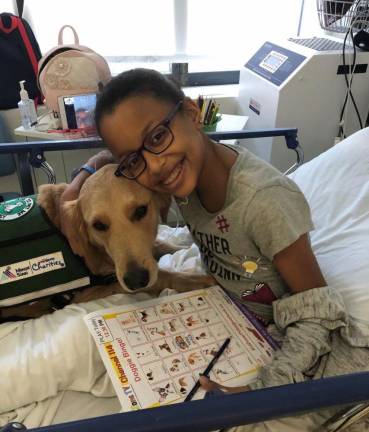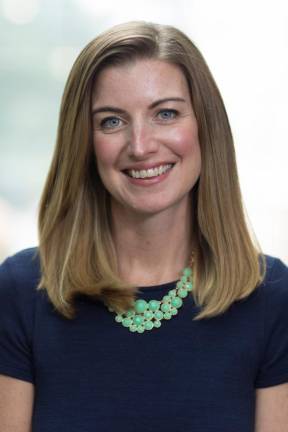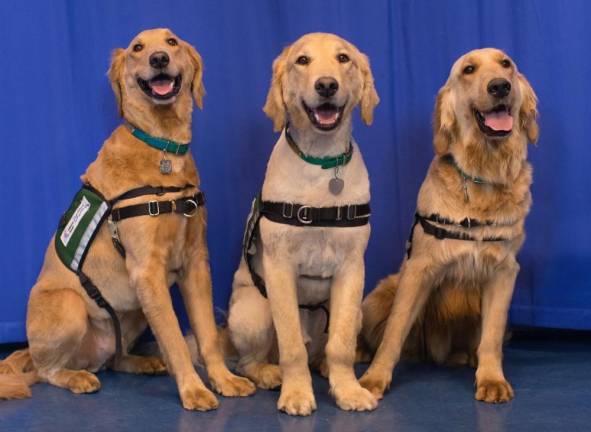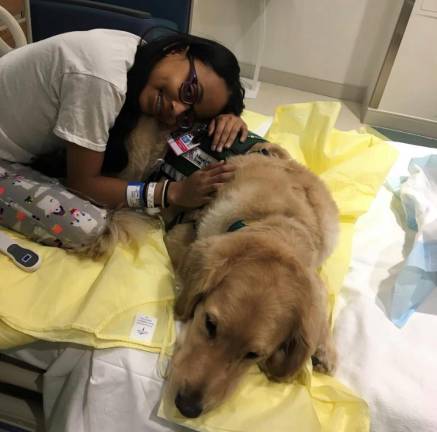Providing Some Fun in a Child’s Hospital Stay
Morgan Stojanowski of Mount Sinai Kravis Children’s Hospital on animal-assisted therapy, brainstorming with teenage patients and using robots during the pandemic




For the kids at Mount Sinai Kravis Children’s Hospital, having to undergo medical treatment can have a bright side because of people like Morgan Stojanowski, Assistant Director of the Child Life and Creative Arts Therapy Department. A child life specialist, she oversees programming using art, play, and music, which helps young patients with the psychosocial challenges and trauma of hospitalization and illness.
The New Jersey native-turned Upper East Sider implemented their Paws & Play program, which uses facility dogs to provide the children with a source of comfort during their time in the hospital. Hired as full-time employees, these three Goldendoodles interact with patients and staff, and this animal-assisted therapy results in improvements in their physical and mental health. A dog named Professor works in their outpatient pediatric hematology oncology clinic and pediatric intensive care unit, while Moby tends to inpatient pediatric units. “A lot of parents have said, ‘I wouldn’t be able to get him or her to come to clinic, but they know they’re going to spend the day with Professor, so they almost look forward to it,’” she said. The hospital’s newest canine addition, Moby, is responsible for the well-being of staff, faculty, and trainees.
Her role also includes facilitating their Youth Advisory Council, which meets once a month in an effort to have 15 to 20-year-olds who have been in the hospital collaborate with staff on best practices. “I have leaders who come to these meetings and say, ‘I think we’re going to roll out this way,’ and the kids say, ‘Why? That doesn’t make sense ... Have you thought about this?’ and no adult in the room had thought about it,” she said.
As for how her work has changed during COVID, she noted learning how to use robots as one adaptation. “We did a quick training and figured out how to drive a robot into a room to deliver art materials so that the art therapists could have a remote session with the patient,” she explained.
You started at Mount Sinai in 2012. As a child life specialist, what does your job entail?
For child life specialists, a large focus of our work is helping children understand why they’re at the hospital or why they’re seeking care, to prepare them for what they will experience, and help them process that through creative arts and play so that they have a sense of control and opportunity for some normalcy. We have a 3,000-square-foot play space called The Zone. We do a lot of work with patient and family engagement, so really bringing the voice of the parent and the child to the forefront. We oversee a NICU Advisory Council, a Parent Advisory Council, and a Youth Advisory Council.
Explain how the children’s hospital is set up.
It’s a children’s hospital within a hospital within a system. We are located on Mount Sinai’s main campus. There are approximately 65 beds including cardiac ICU, pediatric ICU, a med-surge unit, and a unit devoted to hematology oncology. We also have a NICU that’s roughly 55 beds. And then we also have child staff in our pediatric ED and various other outpatient clinics like outpatient hematology oncology, which is where Professor is based. We have a general pediatric clinic and we support some other areas as well.
The first dog you acquired was Professor in 2017.
We paired him with a certified child life specialist, and developed a program based on incorporating animal-assisted therapy into a patient psychosocial treatment plan. So how can we use Professor and his skills to help motivate and support a child and family during a potentially traumatic experience? He helps with pain management, motivation to ambulate, and is a physical comfort. He gives children the opportunity to care for and acknowledge something outside of themselves. These kids identity Professor as their best friend, as their buddy. It’s really a unique relationship that they’re able to form with him. So we were able to leverage funding throughout the years to acquire Amos, our second facility dog, who’s also dedicated to pediatrics.
The hospital also has a dog, Moby, who provides support to your staff.
We really saw with Professor and Amos, how much the staff responded to them and were drawn to them for their own self-care, that it became very apparent to have a facility dog just dedicated to staff wellness. We received funding to acquire our third dog, Moby. He’s paired with a licensed arts therapist and they are dedicated to staff support in the adult hospital. Staff say, “This made my week. I didn’t know if I was going to get through the day and had 15 minutes with Moby and feel like a different person.”
Give us an example of a child who was helped by the Paws & Play program.
I work with a 17-year-old patient, she’s a Youth Advisor member, and she’s talked to me about her sessions. She has said that when she’s experiencing pain, sometimes Professor is the only thing that can offer the distraction and comfort she needs at the moment to get through it. Knowing that it’s going to be a little bit of time before the medicine kicks in, cuddling with him and feeling his weight on her body is the reassurance, distraction, and comfort that she needs to get through that really tough time.
The dogs also help children who have had orthopedic surgeries.
We have a lot of patients who come here for orthopedic surgeries or scoliosis repairs, and part of their recovery is getting out of bed, moving around, and walking. A lot of them can’t go home until they show, for example, they can walk down the hall. But they’re scared to do that; it’s intimidating and they’re afraid of the pain they might experience. But we bring Professor into the equation and say, “You have to take this walk and it might feel scary, but let’s do it with Professor. He’s going to walk with us.” And that can be a huge motivator.
You also facilitate the Youth Advisory Council.
Some are still very active in the treatment process and are admitted frequently, coming to outpatient appointments weekly. Some are more distant from the immediate experience and visit outpatient clinics less frequently. We get together once a month and talk about what we are doing right, what could be improved, and how we are going to get there. It’s everything from the options in the cafeteria to patient confidentiality to as a young adult, when the medical team comes around, how do I want to be spoken to? A big theme that they really worked on this past year was as an adolescent, what makes me feel safe in the hospital when my parent isn’t there?
www.mountsinai.org/locations/kravis-childrens
www.mountsinai.org/locations/kravis-childrens/services/child-family-support/child-life/paws-play